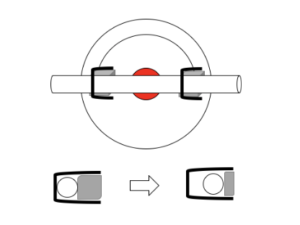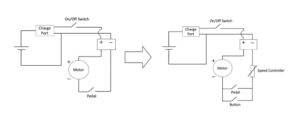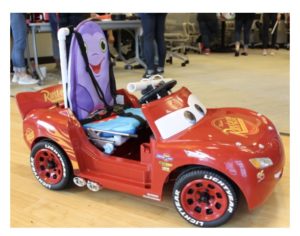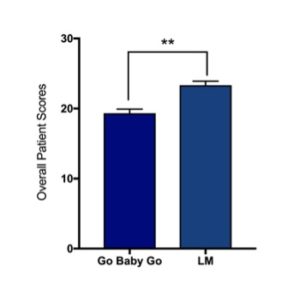Rangers of Motion
Vanderbilt University
Lauren Holtslander, Bachelor of Engineering, 2019
Ethan Jones, Bachelor of Engineering, 2019
Sara Sinno, Bachelor of Engineering, 2019
Robbie Weinstein, Bachelor of Engineering, 2019
Abstract:
Interaction with and stimulation by the environment is critical in normal cognitive development during childhood. However, children with disabilities including premature birth, some cases of autism or spina bifida, may have difficulties with this interaction, simply because they are limited in mobility. This lack of stimulation has been linked to later, more severe mental impairments that may have been otherwise avoidable. Avoiding these complications may be done through the use of a mobility device, but there are currently few options that are low cost and accessible. Additionally, there is a need for mobility devices that can be used for a wide range of children in the setting of a school or day care center. It should be easily adjustable by the parents and caregivers as well as to adapt to growth over time. Previous designs used toy cars and added modifications including augmented steering and supportive seating, but are often only tailored to the individual at a certain age. The modifications included an adjustable, supportive seat fitted with a five-point harness, a novel steering and acceleration system for children with limited upper body mobility and fine motor control, as well as circuit modifications to control the maximum speed of the car. Thus, by using contextualized adaptations of toy cars as well as low-cost materials for modifications, these devices can be utilized by children over time and multiple children in a school setting to allow increased mobility and ultimately stimulate normal cognitive development.
Description of problem
The fundamental problem being addressed through this project is the cognitive development of toddlers with physical disabilities. Throughout childhood, this development is heavily supported through play. For children without disabilities, normal playing includes activities involving both the left and right sides of their brain, provided often by increased mobility in development. However, certain disabilities can prevent children from equally stimulating both brain hemispheres. A lack of brain stimulation in a certain area can prevent it from maturing normally, causing mental impairments that may have been avoided.
Existing toys which disabled children can use to be more mobile and interact with their environment can aid in normal mental development. However, these toys are often made for individuals instead of a wider population or are not adjustable over time to account for the child growing. Since every child has a particular set of physical limitations which have to be considered, there is a need to create an adjustable toy which a school can use to help a wide range of children. These toys have to be enjoyable for the kids to play with, easy for the teachers at the school to adjust, and useful in allowing these children to receive a fully stimulating experience. If these problems are properly addressed, it may allow for schools to have low-cost alternatives for these children as well as increase cognitive maturation.
Project objective statement:
This problem can be addressed using contextualized adaptations of toy cars and the concept of “lean tools” as applied to power mobility chairs. We plan to accurately assess the needs by observation, survey, and hands on experience with the Susan Gray School, an experimental learning school at Vanderbilt that creates a learning environment for normally abled and disabled children to learn together. Further, by collaborating with the Belmont School of Occupational Therapy, professional insight about the structure of the device and the needs of the children can be addressed. By identifying previous failures and future areas for improvement, we will be able to implement an effective, user-friendly, and cost-effective solution to improve childhood mobility. The designs will undergo continuous testing in the school and in the clinic where we will be able to see first-hand the progress of our project.
The final design will increase mobility in developing children of various abilities by providing adjustable modifications to toy cars. These modifications will be adjustable in both up-and-down and front-to-back directions in order to support children of a wide range of ages and sizes. In order to support a wide range of abilities, the modifications will also include aids for steering, mounting, and dismounting. The materials used will be sturdy and cost-effective.
Documentation of final design:
The first main design modification is the addition of a five-point harness to the vehicle (Fig. 1). The harness allows for children with limited upper body strength to remain upright in the vehicle, and maximizes adjustability.

Figure 1. A diagram of the fully adjustable 5-point harness, to be attached to the seat frame.
The second design modification is the redesign of the steering wheel (Fig. 2). The steering wheel was adjusted from the typical vehicular steering wheel to a horizontal piece of PVC. This is important because children with limited upper body strength have difficulties turning a normal steering wheel. With the horizontal turning system, less force needs to be applied to turn the wheel since there is more distance perpendicular to the axis of rotation. A second modification made at the steering wheel is the implementation of a new acceleration mechanism. This new mechanism accelerates the vehicle through the child applying force to the horizontal pipe, which pushes the button down. This new method to drive the vehicle allows for children with limited to no lower body strength to operate the car on their own, which is important for their autonomy.

Figure 2. A diagram of the new modification mechanism, in which PVC pipe is pushed onto a button.
The third design modification made to the vehicle is a sliding mechanism which is used to adjust the position of the seat within the car (Fig. 3). This design modification allows children of various sizes and ages to fit comfortably within the car. This design allows for a single car to fit a wide range of children, as well as an individual child as they grow older.

Figure 3. A diagram of the mechanism used to slide the car seat back and forth in the vehicle.
The final design modifications made to the vehicle were changes within the circuitry of the car (Fig. 4). To implement the button for acceleration, the button was wired in parallel with the existing pedal. Furthermore, a speed controller was added to the car in order to allow parents or occupational therapists to control the maximum speed at which the car could travel.

Figure 4. Modifications made to the internal circuit of the vehicle.
Prototype of the final design:
The final design contains four fundamental modifications to the vehicle in order to enable its use for children with physical disabilities. A photograph of the final design is shown below.

Figure 5. A photograph of the final design prototype.
Below is a link to a video cataloging the building process, a demonstration of the functionality as well as four different clients with various disabilities using the vehicle.
https://vimeo.com/user97716728/review/332077939/1d91392a49
Proof of functionality:
During a day-trip out to a car build at Permobil, we had the capability to test our car on a group of seven children. These children ranged from 9 months old to 4 years old, and had a variety of conditions such as spina bifida, cerebral palsy, and autism. The size and range of the physical capabilities of these children provided an optimal sample for us to test the diversity of patients which could operate our vehicle.
To begin our testing, five categories were selected in which we could measure the efficacy of our vehicle versus a standard Go Baby Go vehicle for each child. These categories were user friendliness, steering functionality, independence, lateral support, and fit. These categories were ranked for each child for both our vehicle and the standard Go Baby Go car, and the differences can be seen below. For children who did not have an opportunity to ride in our car, the value is labeled “n.d.” At the build five of the seven children were able to ride in our modified device, which is a significant improvement over existing devices in which only one child can use any particular car.

Figure 1. Individual efficacy scores between Go Baby Go car and adjustable car for each client.
Once the scores for every child was calculated, a t-test of means was performed on the average overall patient score for our vehicle and the Go Baby Go vehicles. This statistical test showed that our vehicle operated significantly better than existing vehicles.

Figure 2. A significant improvement in overall scores for clients with individually made cars versus the adjustable car (LM). Bars represent averages, error bars represent 95% CI. (**p<0.01)
Results of patent search:
US9663132: Carrying Cart Accomodation for Special Needs Rider
Relevant Claims:
- … a first push handle adapted to be moveable from a first position to a second position and a second push handle adapted to be moveable from a first position to a second position.
- The cart of claim 1 wherein the cart further comprises a harness which is a five point restraint safety belt.
- The cart of claim 1 wherein the seat is inclined downwardly towards the backrest at approximately a five (5) degree angle from a horizontal axis.
US20050275274 – Novel enhanced process for making seating elements and products thereby including those specially designed for children
Relevant Claims
- In a seating apparatus for preventing muscle fatigue and cushioning the spine to increase lordosis in the lumbar spine, the improvement which comprises, in combination: improving venous outflow from the lower extremities in the sitting position by decreasing venous obstruction at the femoral vein level; and using parameters including a distance measurement for a user’s ischial tuberosities to optimize receiving pelvis weight bearing on each of the ischial tuberosities of the involved user.
- The apparatus of claim 2, wherein the parameters further comprise height and weight ranges of prospective users.
- The apparatus of claim 3, wherein at least one set of data points is customized to a particular user.
- The apparatus of claim 11, the algorithm further comprising data points describing a number of other users chosen from a particular segment of the populace.
Anticipated Regulatory pathway:
This device will operate as a prototype to support the intellectual property claims. Therefore, as the IP is licensed to companies or organizations, they will be responsible for utilizing the technology in a method that is compliant with all regulatory bodies with respect to safety and efficacy. However, if this technology were to be launched as an independent product, it would be responsible to follow all rules laid out by ASTM F963-17, or the Standard Consumer Safety Specification for Toy Safety. Furthermore, the Individuals with Disabilities Education Act (IDEA) defines how the technology should be utilized. It lays out the responsibilities by which a school or therapy center must operate with the technology. It is important to note that the IDEA is a federal regulation, and it is likely that other state and local regulations may apply.
Reimbursement:
This device will likely not be reimbursed by Medicare or Medicaid as it is not an FDA approved therapeutic mobility device but rather a modified toy that aids in early development outside of a therapeutic environment.
Estimated manufacturing costs:
The cost of the modified adjustable toy car can be broken down as shown in Table 1.
Table 1. Price breakdown of car components.
| Item | Quantity | Price per unit | Total Price |
| Toy Car | 1 | $100-500 | Variable |
| Kickboard | 1 pack | $11.89 | 11.89 |
| PVC Pipes | 3 | $3.36 | 10.08 |
| U-Brackets | 2 | $4.94 | 9.88 |
| Speed Controller | 1 | $10.99 | 10.99 |
| Seat Adjuster | 1 | $19.74 | 19.74 |
| PVC 2-Way Elbow Connectors | 1 Pack | $7.94 | 7.94 |
| PVC 3-Way Elbow Connectors | 1 Pack | $14.90 | 14.90 |
| Acceleration button | 1 | $11.69 | 11.69 |
| Foam Blocks | 1 | $12.99 | 12.99 |
There are additional considerations regarding manufacturing and assembly. The implementation of the speed controller involves soldering and some modifications involve cutting plastic and PVC pipes that may be dangerous to the consumer.
Potential market:
The end user of our highly adjustable device will be used by children with disabilities; however, the device will often be used under the supervision of a parent or therapist. One of the difficulties faced by those assisting young children with special needs is the inability to effectively develop key skills of the children, such as visual motion tracking and advanced muscle tone. Therefore, although the children are the end user of the product, many of our key design inputs are targeted at the therapists and parents so that they are more readily able to help the children develop by using the device.
We plan to work hand-in-hand with the Susan Gray School in Nashville, TN, in order to optimize the utility of our device. Our device can be utilized in schools, therapy centers, and in the home, given that the device is affordable and adds value in each environment. Sizing this market hinges on the key development disadvantages that will be targeted after observing children with special needs interact with their existing equipment, speaking with industry professionals, and considering our own design capabilities. Rather than trying to tackle as many developmental pitfalls as possible, we aim to take a more targeted approach by developing a device that is extremely effective at addressing a small number of critical needs. We believe that this philosophy will differentiate our device from existing devices, and therefore drive the maximum amount of value toward our end users.
